
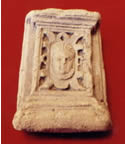
Terracotta Centurion Altar Piece. 1st century AD. 5 x 7 centimeters.
Item has very clear detail and has evidently been protected from the
elements. This artifact displays a Centurion's face in the center. His
helmet is adorned with 12 horizontal feathers and he is wearing a Legionary
scarf. The style of the Centurion's face and the surrounding 12 pointed
decoration may be due to Mithraic influence. Representations of Centurions
are hard to come by and this is a good one.
Price: $1,200.00 US

Silver and Gold Guilded Crossbow Fibula. 1st to 2nd Century AD. 5 x 7 ½ centimeters.
This Fibula has an intricate lead inlay design all along its ridge and
traces of gold plate on the bronze bulbs. One bulb has corroded a bit
due to its age. The bronze pin is intact. The main body of the Fibula
is of a high grade silver and must have belonged to an official or officer
of high rank, possibly of the Senatorial class. The Crossbow Fibula was
popular with Roman soldiers and may have been worn exclusively by them.
Worn on the left shoulder as a pin to hold the toga in place, it was worn
when soldiers were at leisure. The ends of the three points of the crossbow
are bulb shaped. This part of the Fibula was worn facing down, resembling
an upside-down cross. This is a rare piece of ancient roman jewelry and
would complete anyone's Fibula collection.
Price: $ 1,460.00 US
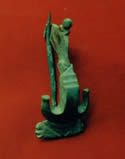
Bronze Navy Fibula. 2nd to 3rd century AD. 3 x 6 ½ centimeters.
This Legionary Fibula was worn by a member of the II Aduitrix which was
stationed in Lower Pannonia (Hungary). According to my research the II
Aduitrix (or elements of) appears to have been stationed with the IV Flavia
Felix in Moesia. (Balkans) The II Adiutrix also appears to have been conducting
itself as Roman Marines, probably patrolling on the Danube. The II Aduitrix
was formed by Vespasian from Marines stationed with the Fleet at Ravenna
in 69 AD (possibly many sailors also volunteered to become legionaries).
After the civil war the II Adiutrix lived on as an Imperial Legion with
its own eagle. This legion also served in Britain under the famed General
Agricola. A very nice item for anyone with an interest in Roman legionary
and Roman nautical.
Price: $700.00 US
Bronze Navy Fibula. 2nd to 3rd century AD. ½ x 7 centimeters.
Nice Fibula that has some corrosion on the pin's eye as at one time it
had an iron pin. The item has been brushed to show the bronze. The following
Roman letters are engraved on the flat of the Fibula: MINN. There is also
a flag pennant engraving. I believe this to be the abbreviation for MIN
Navis, a navy ship stationed at Misenum. This western Mediterranean port,
just north of Naples, was the main port for the Roman Fleet. This artifact
was found with several Roman Navy Fibulas. Nice item particularly for
anyone who has ever sailed with a Mediterranean Fleet.
Price: $1,000.00 US
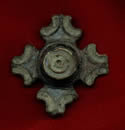
Bronze Legionary Cavalry Fleur Cross Pin of the IV Flavia Felix. 2nd to 3rd century. 3 ¼ x 3 ¼ centimeters.
The item is in good condition but has no pin or pin lip. It has traces
of blue and yellow enamel (now a faint green) and a diamond star shape
of the IV Flavia. In its center it has a Phalera (medal). I have seen
quite a few items with the Fleur cross and can assure you that they all
belonged to members of a German cavalry regiment (Ala) serving with the
IV Flavia in Moesia. Nice item.
Price: $320.00 US
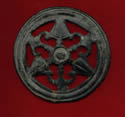
Bronze Roman Marine Armor Chest Boss "Box Strap Type." 2nd century AD. 7 x 7 centimeters.
This artifact is in perfect condition with the exception of one very
small nick on the outer rim. We now know what an Imperial Roman Marine
wore for light body armor - just a heavy bronze disc protecting the solar
plexus. The three anchors and three leather back turtles on the boss lead
to the speculation that this Marine's unit may have been attached to or
in support of the VI Ferrata in Syria or Judea. The three anchors and
three turtles each forming a triangle, give credence to the belief that
this Marine's unit may also have been in support of the III Gallica stationed
in Syria. The center of the boss has a Legionary Phalera (medal). There
are a few rare depictions of Roman Marines in sculptures. There is no
doubt that this piece of armor was used! by a Roman Fleet Legionary (Epi
Betea) during the hot summer months along the coasts of Asia Minor, Syria,
and Judea. According to my research there is no known example of complete
Roman Marine Armor in existence, that is until now. Extremely Rare.
Price: $5,200.00 US
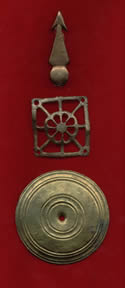
Two Bronze Legionary Phalerae (medals) and a Copper Applique. 1st century AD. Medal # 1- 6 centimeters in diameter. Medal # 2 - 3 ½ x 3 ½ centimeters. Applique - 1 x 5 centimeters.
Two medals that were worn on the leather straps of Legionary armor in
excellent shape, and one applique in excellent shape representing a missile
from a Scorpio (Roman artillery piece). These medals belonged to a Legionary
of an unknown Ballistica (artillery) unit. I have only seen these square
medals in sculptures of the 1st century AD and always on Centurions. This
leads me to believe that these medals belonged to a Centurion who commanded
a Ballistica. Very nice items for a collector interested in Legionary
artillery.
Price: $1,650.00 US
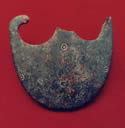
Bronze Legionary Gladius (Sword) Chape. 1st to 2 nd century AD. 6 x 5 ½ centimeters.
This gladius chape has several broken pieces and a small hole in back.
Still it is very attractive as there is hardly anything that is ever found
concerning the legendary gladius except the chapes. This was not an auxiliary's,
but rather a classic Roman Legionary chape. Nice item.
Price: $400.00 US
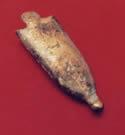
Bronze Legionary Pugio (Dagger) Chape. 1st to 2nd century AD. 4 ½ x 1 ½ centimeters.
This pugio chape is in good condition, with a closed crack in the back.
It has been cleaned and buffed. It is the standard Legionary pugio chape.
Nice item.
Price: $250.00 US
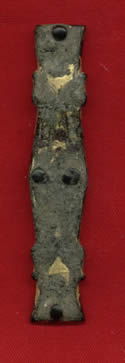
Bronze and Gold Guilded Legionary Officer's Belt Applique. 2nd to 3rd century AD. 6 ½ x 1 centimeters.
Tribunes and Legates were allowed to gold plate their appliques, while
Centurions were allowed to silver plate theirs. This applique has a good
deal of gold guilding, much more of which is probably hidden under the
heavy patina. Nice item.
Price: $300.00 US
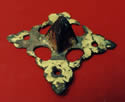
Bronze with Gold Guilding Cavalry Officer's Buckler Shield Boss. 2nd to 3rd century AD. 8 ½ x 7 ½ centimeters.
Although there is a piece broken off, this is still a fine looking shield
boss. This particular Fleur symbol was used by a German Cavalry Ala (Wing)
that was attached to the IV Flavia Felix stationed in Moesia. Rare to
be seen in this style. This boss would be great looking in any Equestrian
collection.
Price: $2,000.00 US
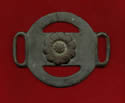
Bronze Equestrian's Horse's Head Armor Boss. 2nd to 3rd century AD. 6 ½ x 8 centimeters.
This is a nice piece featuring a sunflower or daisy motif in the center
of the applique. There is one break on the bottom of the piece but it
does not detract from the looks of this nice piece of horse armor. This
particular Cavalry Ala was attached to the IV Flavia Felix while stationed
in Moesia. Nice item.
Price: $500.00 US

Bronze, Gold Guilded, and Enameled Equestrian Applique. 2nd to 3rd century AD. 2 x 2 centimeters.
This delicate applique with traces of gold guild and blue enamel was
attached to the leather straps of the uniform of an Equestrian officer
stationed with the IV Flavia Felix in Moesia. The applique has a sunflower
or daisy in its center. The blue and yellow (gold) were the colors of
the IV Flavia, while the diamond star was their Legionary symbol. Very
nice item.
Price $340.00 US

Copper Cavalry Spur. 1st to 3rd century AD. 1 x 9 centimeters.
This item, called a hook spur, is in good condition. The spur piece itself
is intact. Nice Item.
Price: $400.00 US
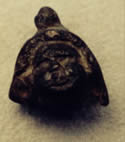
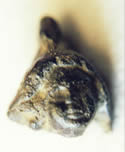
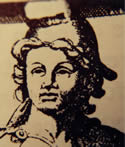
Bronze Sculpture of Mithra. 1st to 2nd century AD. 1 ½ x 2 centimeters.
This item is excellent Greco-Roman art and represents this god in his
classic form. This is a copy from a Tauroctony which shows Mithra in the
act of the bull slaying. The Mithraic religion was popular with the Legions
and disappeared with the advent of Christianity. A mystery cult, none
of the millions of its male members ever gave up the secrets of Mithraism.
Today the best knowledge we have is based on the artifacts from which
we draw much of our understanding of this ancient religion. Rare.
Price: $830.00 US
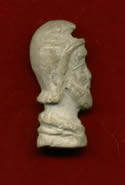
Ivory Sculpture of Aeneas. 1st to 2nd century AD. 1 x 2 ¼ centimeters.
This ivory item is about as good as it gets for miniature sculpture.
This miniature travelling altar piece came from a lot that had a Praetorian
ring and is classic Greco-Roman in style. Aeneas was the mighty hero of
the Trojan war who in ancient literature was reputed to have been the
legendary father of the Roman race. Julius Caesar claimed to be his direct
descendent. Very few depictions of Aeneas exist in Roman form. Rare.
Price: $2,400.00 US


Bronze and Silvered Legionary Miniature Boar Standard. 1st to 2nd century AD. 2 x 3 centimeters.
This Legionary artifact is in excellent condition with the back still
retaining its silvering. One can see a small area where the miniature
pole was evidently attached. On the front just below the boar there is
a small diamond star of the IV Flavia Felix. This item would have been
part of an individual soldier's altar or perhaps his tent or Signifier.
Rare.
Price: $ 2,000.00 US
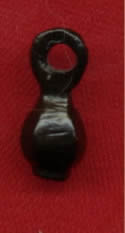
Bronze Miniature Legionary Seal. 2nd Century AD. ½ x 1 ½ centimeters.
This item is in excellent condition. The Legionary seal has the six-pointed
star of the VI Ferrata and the lightning bolt symbol of Jupiter. The seal
was probably worn around the neck and used to stamp official Legionary
documents.Very fine item.
Price: $300.00 US

Bronze Hun Helmet Trophy Pendant. 3rd to 4th Century AD. 2 ¾ x 3 centimeters.
This item is in great shape. It could be set upright as a miniature helmet
sculpture or worn upside down (defeat over the Huns) as a pendant. Nice
item and a true conversation piece.
Price: $480.00 US
See Roman Reproductions, Item # R15
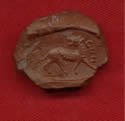
Red Clay Terracotta Document Seal. 1st to 2nd century AD 1 ¾ x 2 centimeters.
This item is in nice shape showing a creature that is a combined horse,
dog, and rooster (you can view the rooster when you look to the right
on the animal's head). The CVII is the legionary abbreviation of the VII
Claudia Pia Fidelis. This item would make a nice addition to a legionary
collection..
Price: $700.00 US
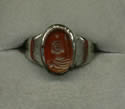
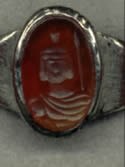
Silver and Amber Praetorian Guard's Intaglio Ring. Circa late 2nd century to early third century. Size 10 ½.
This Ring is in excellent shape considering the age. There is a very
slight chip on the bottom of the intaglio and the silver has 2 small breaks
around the bezel area. The rest of the ring is perfect and very wearable
if you're right handed - The intaglio will be straight on the right hand
ring finger. This ring came in a lot of a Praetorian Officer's Chest Boss
and several rings of a smaller size of the VI Ferrata. It is evident that
this Officer had been at one time a legionary with the VI Ferrata and
had gained enough favor to get transferred to the Praetorians. Amber was
the most expensive precious commodity in the Roman world. The image on
the intaglio has a Praetorian standing in the guard position with his
spear upright but positioned behind him. This spear position was used
when Roman soldiers wanted to assure someone that they were not threatening.
It would be similar to a soldier of today slinging his rifle on his shoulder.
This ring is very elegant and reassuring and shows that the Praetorians
were first and foremost protectors. Extremely rare Praetorian item.
Price: $5,300 US

Bronze Red Carnelian Praetorian (on campaign) Signifier's Intaglio Ring. 1st to 2nd Century AD. Size 9 ½.
This intaglio has one small chip on top and the ring has one small nick
in the same area. The deep burgundy red (the color of the Praetorians'
capes and of Hercules) of this stone combined with the fact that it is
almost certain that it was gold guilded, show that the burgundy and gold
colors of the Praetorians was very much in place. There is a lightning
bolt S on each side of the ring band to show that this was a signifier.
The engraving of the stone is the best I have ever seen, this is immensely
high Greco/Roman art. The lioness has a paw raised looking as if she is
getting ready to take hold of the standard and go on the attack. All signifiers
wore animal heads and skins (with the exception of the Vexillarii and
the Aquiliferi who went bareheaded) and the male lion was the chosen head/skin
of Praetorian standard bearers. The fact that this Praetorian Signifier's
ring portrays a lioness indicates that the standard bearers of the Praetorians
on campaign with a member of the emperor or imperial family member wore
a lioness head/skin. This makes sense as the lioness is the hunter in
that cat family. I am of the opinion that the refined stone engraving
was done in Southern Italy and that the heavy ring was smithed by a provincial
in Moesia. This is an extremely fine and rare Praetorian item.
Price: $5,000 US

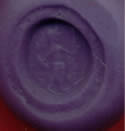
Bronze with Traces of Gold Guilding Brown Carnelian Fides Intaglio Ring. 2nd to 3rd century AD. Size 8.
This ring is in excellent shape but has two extremely fine hairline cracks
in the stone. Not visible to the naked eye this is still an impressive
stone. This depicts a Roman Knight giving the oath of allegiance through
the goddess Fides. On the 6th of January every year the Roman legions
were assembled throughout the Roman empire. An image (statue) of the goddess
Fides was brought to preside over the oath of loyalty to the emperor and
Rome. Officers would draw their swords and hold the sword raised while
the soldiers would raise their hands in salute and recite the oath. The
single victory wreath was sacred to Fides and the F of course is an abbreviated
letter for her name. This ring is a very attractive and significant piece
of legionary history.
Price: $2,200.00 US
See Roman Reproductions, Item # R6

Silver Intaglio Ring. Late 2nd century to early 3rd century AD. Size 7.
This handsome, lopsided, multi-beveled high grade ring is in excellent
condition. The Roman numerals VI and the letter F are engraved on the
bezel. This ring belonged to a lot that when purchased had contained a
Praetorian's ring, and a Praetorian officer's armor chest boss. It belonged
to a legionary of the VI Feratta stationed in Syria and Judea during Imperial
times. It appears to me that this legionary went on to become a Praetorian.
This is ring looks as if it was made by one of today's top jewelry designers.
Very fine item.
Price: $5,000.00 US

Bronze Intaglio Cavalryman's Ring. 1st century AD. Size 7 ½.
This lopsided ring is in excellent condition and has been cleaned and
polished to look new. This ring belonged to a veteran cavalryman of the
VI Victrix who was a member of the XXI Rapax. (Rapax means "grasping,"
referring to the grasping motion made by a screaming eagle). Both Legions
were stationed together in the 1st century in upper Raetia near present
day Belgium. There is a boat symbol next to the VI on the right side of
the band which leads me to believe that this cavalryman may have been
one of the famed Batvians. The cavalryman displayed on the bezel is reminiscent
of Alexander or the typical Cavalry hero. The left side of the ring band
is engraved with the number XXI. In 90 or 91 AD the Rapax was transferred
to Pannonia (present day Hungary). In 92 AD the entire Legion was ambushed
by the Iazyges (a Sarmatian tribe - later known as the Samaritans of biblical
fame) and their German allies. The Rapax was destroyed and the name and
numerals of the 21st legion were never to be heard from again. Interestingly
enough recent archaeology has proved that the Sarmatian tribes counted
women warriors in their ranks. Domitian subdued the Sarmatians the following
year in 93 AD and incorporated them as auxiliary cavalry. This ring was
found in Moesia (present day Balkans) and is a very significant legionary
find. Very Rare.
Price: $2,250.00 US
See Roman Reproductions, Item # R7

Officer's Full Shield Tin Ring. 1st to 2nd century AD. Size 8.
This ring is in excellent condition and has traces of gold guilding on
the shield and gold guilding on the inside of the band. This ring has
the full legionary shield of the IV Flavia Felix on the bezel. There is
an S contained in a bar on each side of the band, indicating that this
ring belonged to a Signifier. The main symbol on the legionary shield
bezel is the diamond star, which is drawn with three intersecting lines
creating a six-pointed cross in the center of a diamond. This symbol appears
to be associated with the north star. The IV Flavia was stationed in ancient
Moesia. Considering the many artifacts that I have studied from that region,
this legion seemed to be strong in using a portion of its force as Roman
Marines. It seems that the IV Flavia did a lot of river patrolling and
also provided forces to ships in the Black Sea. This is an extremely rare
legionary find as we have little information concerning shield designs,
that is except for those on sculpture relief.
Price: $4,150.00 US
See Roman Reproductions, Item # R19

Bronze Blue Enamel Inlay Ring. 2nd century AD. Size 9.
This heavy bronze ring is in great condition. Most of the enamel is present
and the ring has been brushed in one area. This ring has on its bezel
the legionary diamond star of the IV Flavia Felix. This legionary symbol
of the IV Flavia is sometimes depicted by a six-pointed cross formed by
three intersecting lines placed in a diamond. This symbol appears to be
associated with the north star. The colors blue and gold were those of
the IV Flavia. This particular ring insignia looks a lot like the NATO
symbol. The IV Flavia was stationed in ancient Moesia, and considering
the many artifacts that I have studied from that region it appears that
this legion seemed to be strong in using a portion of its force as Roman
Marines. It seems that the IV Flavia did a lot of river patrolling and
also provided forces to ships in the Black Sea. Very nice item.
Price: $650.00 US

Bronze Intaglio Combat Engineers Ring. 2nd to 3rd century AD. Size 8.
Heavy solid ring in great shape and has been cleaned and polished. On
both sides of this ring band there is a diamond with a band across the
middle. The bezel has a ladder (used for siege work) and is flanked by
two jacks, which were were used to create a kind of ancient mine field.
There would be no Cavalry ambushing a ground peppered with these. It is
evident that this ring belonged to a Combat Engineer of the IV Flavia
Felix. Very unique and ready to wear.
Price: $830.00 US
See Roman Reproductions, Item # R9

Bronze Legionary Doctor's Intaglio Ring. 2nd to 3rd century AD. Size 8 ½.
Very nice ring that has been cleaned and polished. This ring depicts
a Pelican on the bezel. The Pelican was known as a creature which would
peck flesh from its own breasts in order to feed its young. Hence the
symbolism of caregiving and also bloodletting. Legionary Doctors (who
were mostly Greeks) were considered the best in the world and did not
have an equal until modern times. On each side of the band there is a
shield with a caduceus on it. This symbol has always been associated with
merchants and medicine. Flanked on the side of each shield is a V. This
type of ring is almost always found with five-pointed star rings and is
of the same ring style. This is a Legionary Doctor's ring of the V Macedonia.
Rare and Nice.
Price: $1,100.00 US
See Roman Reproductions, Item # R10

Bronze Intaglio Ring. 2nd to 3rd century AD. Size 10 ½.
Nice ring with the band slightly bent and a small crack near the bezel
and about half way across the band, however both are on the outside only.
The ring has been partially cleaned and buffed. The bezel of this ring
has two cross palms mounted with the cross symbol for Jupiter. Running
on top of this symbol is a small cross which makes it look Christian.
There is a line across the symbol which signifies veteran. On each side
of the band is decoration with a wheat laurel. Looks like this could have
belonged to a legionary Christian who was a veteran of the III Cyrenaica
which was garrisoned in Egypt.
Price: $500.00 US
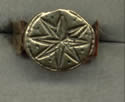
Bronze Intaglio Ring. 3rd century AD. Size 8.
Nice ring which has been cleaned and buffed, there is a small piece missing
on one of the sides and on the bottom. Overall it is in great shape. This
ring has an eight-pointed star that is distinct from the diamond star
crosses as it is completely symmetrical. This is a ring that belonged
to a Legionary of the VIII Augusta stationed in Moesia. There are three
shields with one on each side and one on the bottom. This is the first
time I have ever seen the bottom shield. Each shield has the six-pointed
line cross indicating the wearer was under the protection of Jupiter.
Very attractive and nice, ready to wear legionary ring.
Price: $700.00 US
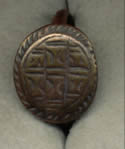
Bronze Jewish Auxiliary Shield Seal Ring. 2nd century AD.
This ring is in excellent all around condition. It has two rows of three
He (pronounced Hi), the Jewish letter symbol for life. This was found
with other legionary rings in the Balkans and so may have belonged to
a Jewish auxiliary who was an archer or slinger in the service of the
Roman Army. However it could also be that this ring was booty won by a
legionary who served in Judea during the Jewish wars. Either way an attractive
and rare item.
Price: $1,300.00 US
See Roman Reproductions, Item # R12